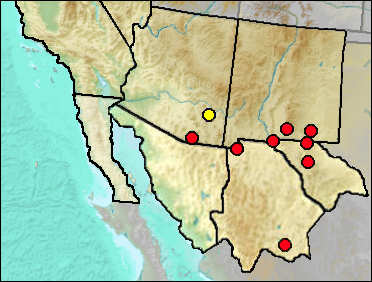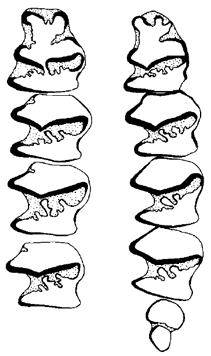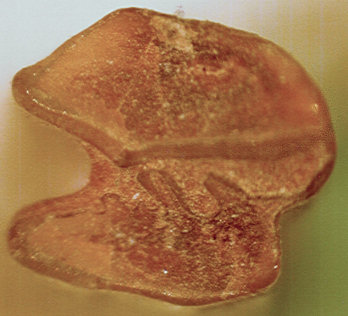Class Mammalia
Order Lagomorpha
Family Leporidae

 This is a very small lagomorph. The tooth
patterns of p3 through m2 provide easy identification of lower teeth (Fig. 1). Most
specimens display a dentine lake medial to the posterior-lateral reentrant on p3, but a
few have the reentrant extending to the medial side, as seen in Fig. 1 on the right.
The origin of the lower incisor is some distance anterior to p3, unlike the situation
in Sylvilagus, where the base of the incisor butts up against p3. p4 - m2 differ
from other regional lagomorphs by the extreme loops of enamel on the posterior wall of
the lateral reentrant (Figs. 1, 2). Skull parts and upper teeth have not been surely
recognized.
This is a very small lagomorph. The tooth
patterns of p3 through m2 provide easy identification of lower teeth (Fig. 1). Most
specimens display a dentine lake medial to the posterior-lateral reentrant on p3, but a
few have the reentrant extending to the medial side, as seen in Fig. 1 on the right.
The origin of the lower incisor is some distance anterior to p3, unlike the situation
in Sylvilagus, where the base of the incisor butts up against p3. p4 - m2 differ
from other regional lagomorphs by the extreme loops of enamel on the posterior wall of
the lateral reentrant (Figs. 1, 2). Skull parts and upper teeth have not been surely
recognized.
Fig. 1. Lower left tooth row (holotype, UTEP 1-1202) of Aztlanolagus agilis (left) and left tooth row of 5689-6-29 showing the rare Lepus pattern. Figure after Russell and Harris (1986).
The proportions of the limb bones suggest cursorial habits closer to those of jackrabbits than cottontails; this, in turn, suggests occupation of relatively open country. Occurrence with both Lepus and Sylvilagus (and possibly with more than one species of each) indicates it possessed a unique ecological niche.
The holotype, UTEP 1-1202, is an incomplete left dentary from the Room of the Vanishing Floor, Dry Cave, Eddy County, New Mexico.
The geologic age extends from Late Blancan (111 Ranch of Arizona) to Irvingtonian deposits in Fyllan Cave, near Austin, Texas (Winkler and Tomida 1988) and to at least as recent as mid Wisconsin in New Mexico (Russell and Harris 1986). Some specimens from New Mexico (and possibly those from Chihuahua) may be late Wisconsin: they are recorded from U-Bar Cave in sediments dated as late as 13 to 14 ka (Harris 1989), but sufficient contamination exists in those strata as to prevent a definite statement of survival. Occurrence at Dust Cave near the southern end of the Guadalupe Mountains also may be late Wisconsin, but seems anomalous (Harris and Hearst 2012). It is safest at this point to consider them as definitely mid Wisconsin, but that occurrence in late Wisconsin time is uncertain.

Fig. 2. Left lower cheek tooth of the Aztlán Rabbit showing the typical looping of the enamel on the posterior wall of the reentrant. Specimen from U-Bar Cave, Hidalgo Co., NM.
The known geographic range of this small rabbit is from eastern Arizona to central Texas and from central Colorado on the north to southern Chihuahua, Mexico, on the south.
Sites.
Pleistocene: Anthony Gap Cave (Russell and Harris 1986).
Late Blancan: 111 Ranch (Morgan and White 2005).
Early/Early-Mid Wisconsin: Lost Valley (Russell and Harris 1986); Room of the Vanishing Floor (Russell and Harris 1986); Sabertooth Camel Maze (Russell and Harris 1986).
Mid/Late Wisconsin/Holocene: Jimenez Cave (Messing 1986).
Mid Wisconsin: Papago Springs Cave (Czaplewski and Mead et al. 1999); Pendejo Cave (Harris 2003); U-Bar Cave (Russell and Harris 1986).
Late Wisconsin: Dust Cave (Harris and Hearst 2012).
Mid/Late Wisconsin/Holocene: Sierra Diablo Cave (UTEP).
Late Wisconsin: U-Bar Cave 13-14 ka (Harris 1989); U-Bar Cave 14-15 ka (Harris 1989); U-Bar Cave 15-18 ka (Harris 1989); U-Bar Cave 18-20 ka (Harris 1989).
Literature. Czaplewski and Mead et al. 1999; Harris 1989, 2003; Harris and Hearst 2012; Messing 1986; Morgan and White 2005; Russell and Harris 1986, Winkler and Tomida 1988.
Last Update: 24 Oct 2013